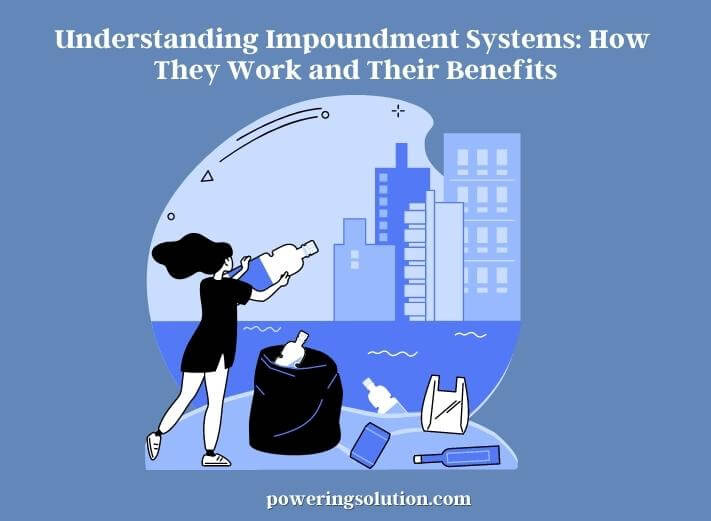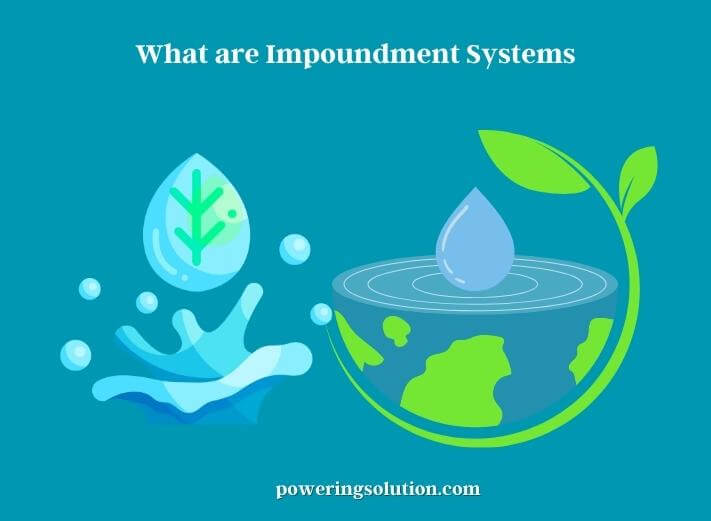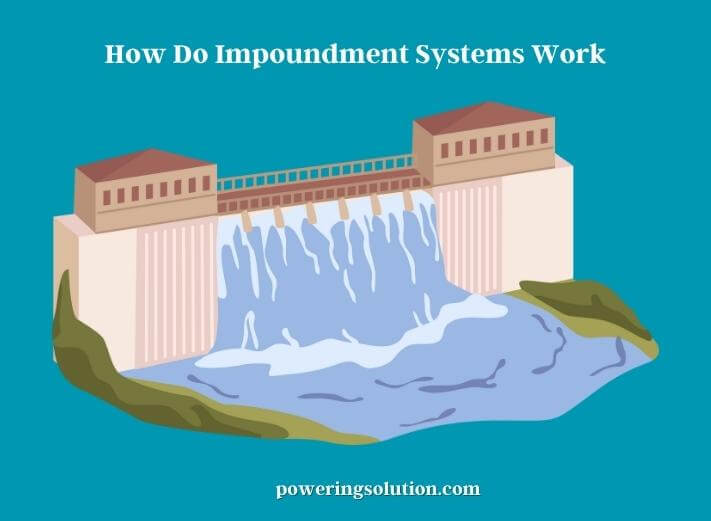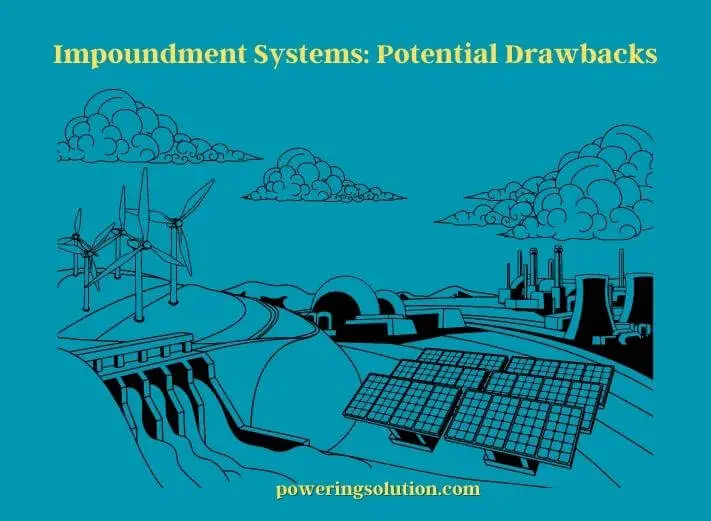Impoundment systems play a crucial role in the modern world by collecting, storing, and releasing water for various purposes. From flood control and irrigation to hydroelectric power generation and water supply for municipalities and industry, these systems offer numerous benefits. They also have potential drawbacks, including environmental impacts and the risk of dam failure.

We will dive deeper into the basics of impoundment systems, including how they work, their benefits, and potential drawbacks. We will explore the different types of impoundment systems, their functions, and how they are managed and maintained. We will also discuss the importance of these systems in modern society and their impact on the environment.
What are Impoundment Systems?
Impoundment systems are structures designed to collect and store water, typically by constructing a dam or embankment to create an artificial reservoir. These systems are commonly used for various purposes, including flood control, irrigation, hydroelectric power generation, and water supply for municipalities and industries.
When a dam or embankment is built, it creates a barrier across a river or stream, causing the water to back up and form a reservoir. This water can then be released as needed for various purposes, such as irrigation or hydropower generation.

Impoundment systems can also help to control floods by holding back excess water during heavy rainfall and releasing it gradually to prevent downstream flooding.
How Do Impoundment Systems Work?
Impoundment systems work by collecting and storing water in an artificial reservoir created by a dam or embankment. The water is then released as needed for various purposes, such as irrigation, hydropower generation, and municipal or industrial water supply.
When a dam or embankment is constructed, it creates a barrier across a river or stream, causing the water to back up and form a reservoir. This stored water can then be released through a controlled outlet or spillway to meet the needs of downstream users.
The release of water from an impoundment system is typically managed and controlled by a set of gates, valves, or other mechanisms. These mechanisms allow for precise control over the flow of water, ensuring that the water is released at a rate that meets the needs of downstream users without causing flooding or other negative impacts.

To release water for various purposes, impoundment systems can also be used to store water during times of excess flow. This stored water can then be released during periods of low flow to help maintain water levels and ensure a consistent supply for downstream users.
Impoundment systems play a critical role in managing water resources and meeting the needs of various human activities. Their operation must be carefully managed to prevent negative impacts on the environment and downstream communities.
Types of Impoundment Systems
Impoundment systems come in various types, each with its unique features and benefits. Some of the most common types of impoundment systems are below:
Gravity Dams
Gravity dams are the most common type of impoundment system and rely on their weight to resist the pressure of water. They are typically constructed of concrete or masonry and designed to resist the horizontal forces generated by the water.
Embankment Dams
Embankment dams are constructed by building a wall of soil or rock that is compacted to form a stable embankment. They are typically used in areas where the foundation is not suitable for a gravity dam.
Arch Dams
Arch dams are designed to resist the horizontal forces generated by the water by transferring them to the abutments at the sides of the dam. They are typically constructed of concrete and are shaped like curved arches.
Buttress Dams
Buttress dams are similar to gravity dams, but they have buttresses that support the weight of the dam. They are typically used in areas where the foundation is weak or where the dam needs to be thin and lightweight.
Concrete Face Rockfill Dams
Concrete face rockfill dams are a combination of a concrete face and an embankment dam. They have a concrete face that protects the embankment from erosion and provides stability, and the embankment is constructed of rock or other materials.
Multi-purpose Impoundment Systems
Multi-purpose impoundment systems are designed to serve multiple purposes, such as flood control, irrigation, power generation, and recreation. These systems often include a combination of reservoirs, canals, and other infrastructure.

The type of impoundment system used will depend on various factors, including the purpose of the system, the characteristics of the site, and the environmental and regulatory considerations.
Benefits of Impoundment Systems
Impoundment systems offer several benefits, including:
Flood Control
Impoundment systems are essential for flood control. They help regulate water flow and reduce the risk of flooding downstream. During heavy rain or snowmelt, water is stored in the reservoir behind the dam, preventing downstream flooding. When the downstream water levels are low, water is released to maintain a steady flow.
Irrigation
Impoundment systems are widely used for irrigation. Water stored in the reservoir is released as needed to irrigate crops, ensuring that they have the necessary water supply. This helps increase agricultural productivity and ensures food security.
Hydroelectric Power Generation
Impoundment systems are a significant source of hydroelectric power. Water stored in the reservoir is released through turbines, generating electricity. This clean and renewable energy source is essential for meeting the world’s growing energy demand.
You have to know that run-of-river hydroelectric systems are a type of hydroelectric power generation technology that harnesses the kinetic energy of flowing water to generate electricity.
Water Supply
Impoundment systems provide water supply for municipalities and industry. Water stored in the reservoir is treated and distributed to homes and businesses, ensuring a reliable water supply.
Recreational Activities
Impoundment systems also provide recreational opportunities such as fishing, boating, and swimming. These activities help boost the local economy and provide a source of enjoyment for residents and visitors alike.
Impoundment Systems: Potential Drawbacks
While impoundment systems offer numerous benefits, they also have potential drawbacks that must be considered.

Environmental Impacts
The construction of dams and embankments can have significant impacts on the surrounding ecosystem. These impacts can include changes to water temperature and quality, habitat fragmentation, and altered river flows, which can impact fish populations, wildlife, and other aquatic organisms.
Risk of Dam Failure
Impoundment systems pose a risk of dam failure, which can result in catastrophic flooding downstream. While modern dams are designed to be safe and reliable, there is always a risk of failure due to natural disasters, structural problems, or human error.
Reservoir Sedimentation
Over time, sediment can accumulate in the reservoir of an impoundment system, reducing its storage capacity and potentially impacting its function. Removing sediment from a reservoir can be costly and time-consuming.
Displacement of Communities
The construction of impoundment systems can result in the displacement of communities and the loss of cultural heritage sites. These impacts can be particularly significant in areas where indigenous peoples or other marginalized communities reside.
High Upfront Costs
Building an impoundment system can be expensive, requiring significant upfront investment. The cost of constructing and maintaining these systems must be balanced against their benefits to determine their economic viability.
While impoundment systems offer numerous benefits, their potential drawbacks must be carefully considered and managed to minimize negative impacts on the environment and downstream communities.
Impoundment System Safety
Ensuring the safety of impoundment systems is critical to preventing catastrophic failures and protecting downstream communities and the environment. Impoundment system safety involves a range of measures, including design and construction standards, regular inspections and maintenance, and emergency response planning.
Design and construction standards for impoundment systems are established by regulatory agencies and industry organizations to ensure that dams and embankments are safe and reliable. These standards cover various aspects of impoundment system design, including spillway capacity, seepage control, foundation stability, and earthquake resistance.
Regular inspections and maintenance are also essential to impoundment system safety. These inspections can identify potential problems or hazards and allow for repairs or corrective action to be taken before they become more significant issues. Maintenance activities may include repairs to gates and valves, vegetation management on the embankment, and sediment removal from the reservoir.
Emergency response planning is another critical aspect of impoundment system safety. These plans outline the procedures for responding to various types of emergencies, including dam failures, natural disasters, and human-caused incidents. Emergency response plans may include evacuation procedures, communication protocols, and actions to be taken to minimize damage and protect downstream communities.
Ensuring the safety of impoundment systems requires a comprehensive approach that includes design and construction standards, regular inspections and maintenance, and emergency response planning.
Factors Affecting the Design of Impoundment Systems
The design of an impoundment system is influenced by a variety of factors, including the purpose of the system, the characteristics of the site, and environmental and regulatory considerations. Some of the primary factors that can affect the design of impoundment systems are below:
- Purpose: The primary purpose of an impoundment system will influence its design. For example, a system designed for flood control will require a larger spillway capacity than a system designed for water storage.
- Site Characteristics: The physical characteristics of the site, such as the topography, soil type, and geology, can also influence the design of an impoundment system. For example, the foundation of the system must be stable and capable of supporting the weight of the embankment and reservoir.
- Hydrology: The hydrology of the site, including factors such as precipitation patterns and surface water runoff, can impact the design of impoundment systems. These factors influence the amount of water that will be stored in the reservoir and the frequency and severity of flood events.
- Environmental Considerations: Environmental considerations, such as the presence of endangered species or sensitive ecosystems, must also be taken into account in the design of impoundment systems. The construction of a system can impact the local environment and wildlife, and mitigation measures may need to be put in place to minimize these impacts.
- Regulatory Considerations: Impoundment systems are subject to a range of regulatory requirements and permits. These regulations can impact the design of the system, including requirements for spillway capacity, seepage control, and emergency action planning.
Bottom Line
Impoundment systems are important infrastructures that serve a variety of purposes, from flood control to power generation and irrigation. Understanding how impoundment systems work and their potential drawbacks is crucial for ensuring their safety and effectiveness.
Factors such as site characteristics, environmental considerations, and regulatory requirements can all influence the design and selection of impoundment systems.
As technology advances and new challenges arise, the development of innovative and sustainable impoundment systems will continue to play a crucial role in addressing the world’s water management needs.
If you want to know about the versatility of evacuated tube collectors, read here for a detailed explanation.
